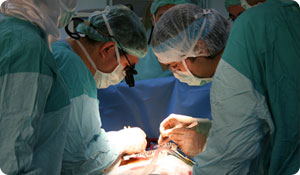
Questions of the heart aren't only for romantics and pop musicians. Cardiologists face plenty of them too. Of course, rather than ruminating on love, heart doctors have to weigh medical decisions that often have no clear right or wrong answers. One of their most common dilemmas is whether to recommend stents or bypass surgery to patients with severe coronary artery disease (CAD). If you're dealing with CAD, doctors may leave the final choice up to you, so it's important to understand the pros and cons of each option.
The Procedures
Both coronary bypass surgery and coronary artery stenting are used to help manage symptoms and improve the quality of life for patients with significant plaque buildup in their arteries. In bypass surgery, known as coronary artery bypass graft (or CABG, pronounced "cabbage"), doctors take healthy blood vessels from other parts of the body (usually the leg or chest wall) and graft those to coronary vessels to create alternative pathways around the plaque-filled arteries. This means blood can once again flow well. In stenting, doctors place a mesh tube in the blocked artery that acts like a tunnel support to keep the vessel propped open wide for blood flow.
Since the 1990s, stenting has increasingly been seen as a better choice to most patients because it is less invasive and has a shorter recovery period than bypass surgery. An increasing body of research, however, is showing that there are instances when bypass surgery would be a better course of treatment. Researchers have also been shining light on the limitations of each procedure, which you should consider when making a decision about treatment.
Pros and Cons
Both of these procedures have been shown to relieve chest pain (or angina), reduce the risk of heart attack following an acute myocardial infarction, and improve a patient's quality of life. While there has been a lot of conflicting research as to which option is best, doctors do often agree on these common points:
When it comes to bypass surgery:
- Bypass surgery is probably a better choice for patients with left main CAD or multivessel CAD (blockages in two or more vessels).
- Bypass surgery may also lower the mortality risk for those with other health complications such as diabetes or those who are 65 and older.
Keep in mind that while the survival rate with bypass surgery seems to be better for some groups of patients, doctors can't definitively say that bypass surgery is more effective since no wide-scale studies have been able to compare treatment in patients who are comparatively similar.
When it comes to stenting:
- Patients under 55 years of age seem to do better with stenting or similar procedures such as balloon angioplasty.
- Patients with low-risk CAD seem to fare the same with stenting or bypass surgery; since stenting is less invasive, though, it may be a better choice for treatment.
The creation of scar tissue following stenting has been a common risk associated with the procedure. This scar tissue can build up and lead, again, to a blockage in the artery. However, newer drug-eluting stents seem to decrease scarring and make this less of a problem.
A Treatment, Not a Cure
As more and more patients undergo these procedures, there has been significant backlash with detractors claiming that stenting, especially, is often used in cases where it is not necessary. Critics point to research showing that, while bypass surgery and stenting may relieve symptoms such as chest pain, neither improves a patient's overall health and may not reduce the risk of heart attacks.
Debates over when, if, and which of these procedures are most effective will continue well into the foreseeable future. Despite the controversy, one thing that's clear is that you should not consider bypass surgery or stenting a cure for CAD. These treatments help you manage symptoms but you're still at risk for problems related to heart disease. If you choose to undergo one of the procedures, you should consider it to be just a part of your overall plan to manage your cardiovascular health. Other efforts might include taking anti-anginal medications, statins, or antihypertensives. You should also commit to not smoking, controlling diabetes, and eating well.
Sources:
Boden, William E. M.D., et. al. "Optimal Medical Therapy with or without PCI for Stable Coronary Disease." The New England Journal of Medicine. 10.1056/NEJMoa070829 (2007). March 26, 2007. Web. May 24, 2012
http://www.nejm.org/doi/full/10.1056/NEJMoa070829
Oz, Mehmet, M.D. "Heart Repair: Bypass or Angioplasty?"AARP Magazine. January 2011. Web May 24, 2012.
http://www.aarp.org/health/conditions-treatments/info-01-2011/dr-oz-heart-surgery.html
Rimmerman, Curtis M. "Coronary Artery Disease." Cleveland Clinic. nod. Web. May 24, 2012
Weintraub, William S., M.D, et. al. "Comparative Effectiveness of Revascularization Strategies." The New England Journal of Medicine. 10.1056/NEJMoa1110717 (2012) March 27, 2012. Web. May 24, 2012
http://www.nejm.org/doi/full/10.1056/NEJMoa1110717?query=featured_home





